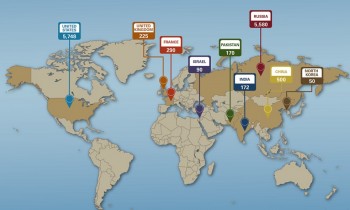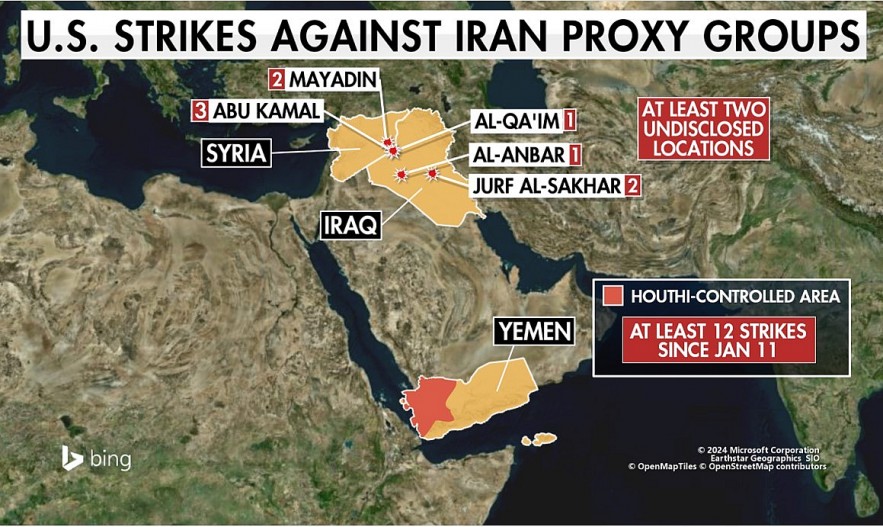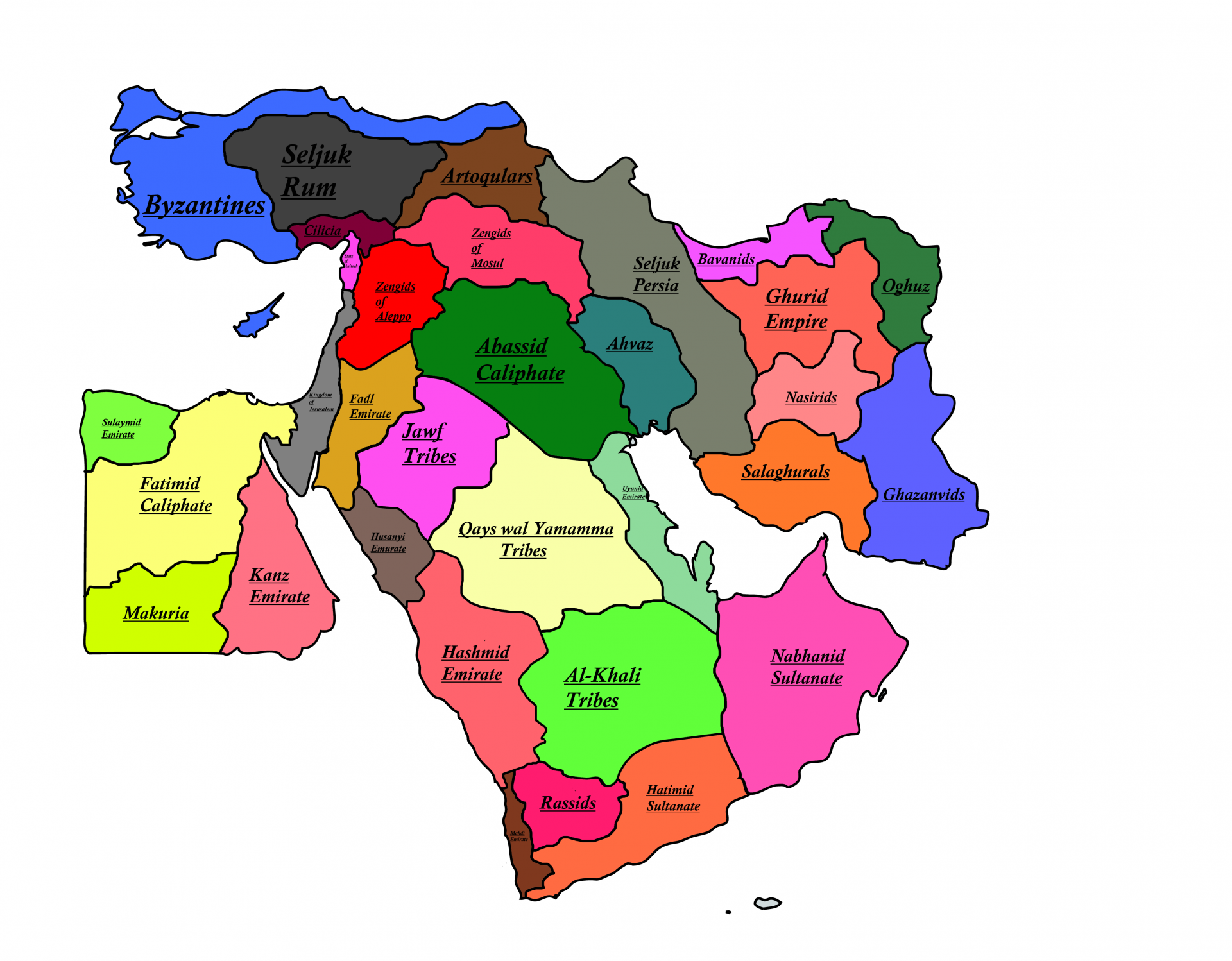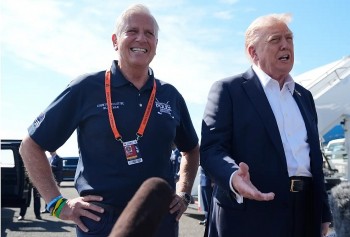Possible U.S. Strike on Iran: What It Means and Where It Could Lead (Update)
 Which Countries Possess Nuclear Weapons in 2025? List of Nations Are Nuclear-Ready Which Countries Possess Nuclear Weapons in 2025? List of Nations Are Nuclear-Ready After Ukraine gave up its nuclear arsenal, nine countries have officially declared possession of nuclear weapons as of 2025. |
 Inside Putin's Nuclear Briefcase (Cheget) and the Secrets of Russia’s Nuclear Arsenal Inside Putin's Nuclear Briefcase (Cheget) and the Secrets of Russia’s Nuclear Arsenal Always within reach of President Vladimir Putin, the nuclear briefcase — ominously known as the "Cheget" — stands as a chilling symbol of ultimate authority. ... |
 |
| Possible U.S. Strike on Iran |
Tensions Escalate Toward a Critical Decision
As of the late evening of June 18, 2025, the United States appears to be edging closer to a potential direct military strike on Iran.
The trigger? A devastating exchange of attacks between Israel and Iran that began in early June, culminating in intense airstrikes on Iranian nuclear facilities and retaliatory missile barrages against Israeli territory. The situation is not only a flashpoint in the Middle East—it has become a global security crisis drawing in world powers and putting the U.S. president in the hot seat.
President Donald Trump has left the door wide open for military engagement, telling reporters on June 18, “I may do it. I may not do it. Nobody knows what I’m going to do.” Despite the ambiguity, his administration's posture has shifted dramatically toward readiness. That same day, Trump convened a high-level meeting in the White House Situation Room with key members of the Cabinet and the national security team. The meeting reportedly focused on finalizing potential military responses and assessing Iranian capabilities and alliances.
Meanwhile, Iran’s Supreme Leader Ayatollah Ali Khamenei has issued sharp warnings. In a nationally broadcast address, he declared that Iran “will not surrender” and that any U.S. involvement would cause “irreparable damage.” As air raid sirens blared across Tehran and Tel Aviv, highways in both capitals became choked with fleeing civilians.
Read more: Inside Iran’s Nuclear Fortress: The Truth About the Mountain-Deep Centrifuge Halls
Possible U.S. Strike on Iran: Timeline of Key Developments (Update)
June 12–13: Israel initiates “Operation Iron Resolve,” a massive air campaign targeting over 100 Iranian military and nuclear sites, including facilities in Natanz, Fordow, and Parchin. Covert Mossad drones reportedly assist in targeting high-value IRGC commanders.
June 14–16: Iran retaliates with over 150 ballistic missiles and more than 100 suicide drones. While Israel's Iron Dome intercepts many, several missiles hit civilian areas. One missile explodes near U.S. consular facilities in Tel Aviv, prompting a security alert.
June 17: President Trump issues a blunt threat to Iran’s leadership, calling Khamenei an “easy target” and demanding “unconditional surrender.” Khamenei responds by rejecting diplomacy “under duress.”
June 18:
-
Trump meets with his national security team. He tells the press he hasn’t made a final decision: “I like to make a final decision one second before it’s due, because things change.”
-
The U.S. begins evacuating American citizens from Israel via charter flights and cruise ships.
-
Iran initiates internet restrictions to control information flow and prevent foreign cyber influence.
-
Anti-Iranian hackers attack a major Iranian cryptocurrency platform, destroying nearly $90 million.
U.S. Decision-Making: Strategic Ambiguity or Calculated Delay?
Trump's public remarks convey a deep internal conflict: the president doesn’t want another Middle East war, but believes allowing Iran to acquire nuclear weapons would be catastrophic. “Too much devastation. And they’d use it, you know? I believe they’d use it,” Trump stated during a press briefing.
He also emphasized that Iran was “just a few weeks away” from achieving a viable nuclear warhead, according to U.S. intelligence briefings. Trump said that Iran had a chance to avoid conflict by agreeing to terms that were “a fair deal,” but that now the terms would be far harsher.
In a political twist, Trump revealed that conservative commentator Tucker Carlson had privately apologized for publicly criticizing his handling of Iran. Carlson, who hosts a top show on X, previously accused Trump of being “complicit in an act of war.” Trump brushed it off, calling Carlson “kooky” on Truth Social. Still, the spat highlights a broader divide within the MAGA movement—between hawkish neoconservatives and isolationist America First advocates.
International Response: The Great Power Triangle—Russia, China, and Europe
Russia’s Red Line
Deputy Foreign Minister Sergei Ryabkov warned on June 18 that any U.S. strike on Iran would lead to “radical destabilization” of the Middle East and possibly “nuclear catastrophe.” Moscow has offered to mediate and accused Israel of violating international law by attacking Iran’s nuclear infrastructure.
President Putin, in a rare joint press conference with Iranian officials following a June 15 treaty ratification, said any further escalation could unite Iran’s fragmented political factions into a single anti-Western front. Russia has also increased its naval surveillance in the eastern Mediterranean.
China’s Strategic Posture
China has called for a cease-fire and stated support for Iran’s sovereignty. In a statement issued through the Foreign Ministry, Beijing emphasized the importance of “mutual restraint and dialogue.” President Xi Jinping has ordered the evacuation of Chinese nationals from both Israel and Iran, signaling concern that conflict could severely disrupt energy markets and Chinese Belt & Road investments.
Chinese state media has criticized U.S. “double standards” on nuclear non-proliferation and warned that any American strike would “further destabilize global markets.”
Europe and NATO
European reaction has been mixed. Germany’s Chancellor Friedrich Merz drew fire after suggesting that “total destruction” of Iran’s nuclear capacity should remain on the table. Iran promptly summoned the German ambassador, calling the remarks “offensive.”
The EU has proposed an emergency summit in Brussels to de-escalate the crisis and offer Tehran a pathway back to the negotiating table. NATO has raised readiness levels but stopped short of offering direct involvement.
The Digital and Civilian Front: Evacuations, Cyberwar, and Information Control
Civilian Impact
In Tehran and Tel Aviv, airstrikes have forced tens of thousands to seek shelter or flee entirely. Tehran’s highways are in gridlock, with families attempting to escape further Israeli bombardment. Israel’s National Emergency Authority has warned of prolonged disruptions in central cities.
Evacuation Operations
U.S. Ambassador Mike Huckabee confirmed that the State Department has organized multiple evacuation channels for Americans, including charter flights and cruise ship departures. He urged all U.S. citizens in the region to enroll in the State Department’s STEP program for updates.
Cyberwarfare and Information Crackdowns
Iran has implemented targeted internet blackouts in several provinces, citing national security. The move follows a cyberattack by a pro-Israel hacking group that targeted one of Iran’s largest cryptocurrency exchanges, wiping out nearly $90 million in assets.
Domestic Politics: Unity or Division?
Trump faces sharp divisions within the Republican Party:
-
Hawkish Republicans: Urge a firm response to protect Israel and prevent Iranian nuclear armament.
-
Isolationist MAGA voices: Warn against another endless war and call for diplomacy.
The ideological rift was spotlighted in a viral interview between Tucker Carlson and Sen. Ted Cruz, where Carlson accused Cruz of “pushing regime change again.” Trump, walking a fine line, continues to court both factions.
Strategic Considerations and Military Assets
Military Readiness
-
The U.S. has deployed multiple carrier strike groups to the Arabian Sea.
-
F-22 and F-35 aircraft are stationed in undisclosed regional bases.
-
Bunker-busting GBU-57 Massive Ordnance Penetrators have reportedly been loaded and prepared.
Legal Authority
No formal Congressional authorization has been issued. Trump could order a limited strike under existing executive authority, but a prolonged campaign would invite scrutiny under the War Powers Resolution.
7.3 Intelligence Indicators
-
Satellite imagery shows Iranian missiles repositioning.
-
U.S. and Israeli intelligence indicate Fordow may be enriching uranium beyond prior thresholds.
The Next 72 Hours: What to Watch
President Trump told reporters, “The next week is going to be very big. Maybe less than a week.” Analysts believe a decision could come within hours. Key indicators include:
-
Formal military orders from the Pentagon
-
Further evacuations of U.S. personnel and allies
-
New Iranian strikes targeting U.S. forces in Iraq or Syria
-
Breakthrough or failure in back-channel diplomacy involving Russia or China
The world is holding its breath. With nuclear facilities in play, cyberattacks escalating, and regional powers aligning, the decisions made in Washington over the next 72 hours could reshape global order for a generation.
 Top 10 Most Beautiful Mosques in the Middle East Top 10 Most Beautiful Mosques in the Middle East Whether modern or traditionally ornate, a mosque celebrates the purity of the Islamic faith. Check out the 10 most beautiful mosques in the Middle East ... |
 How Many Countries Are There In The Middle East Today: Facts, Figures and Population How Many Countries Are There In The Middle East Today: Facts, Figures and Population The Middle East includes countries that share common factors like ethnic groups, geographic features, religious beliefs, and political history. How many countries are there in ... |
 12 Weirdest CIA Programs in History 12 Weirdest CIA Programs in History There have been several debates surrounding the Central Intelligence Agency (CIA), both domestically and internationally. View the list of the Top 12 Weirdest CIA Programs ... |
 Can American Travel to Iran? Can American Travel to Iran? U.S. citizens may be wondering if they should or can visit Iran right now, given the uncertainty surrounding US-Iranian relations and rumors of changing political ... |























